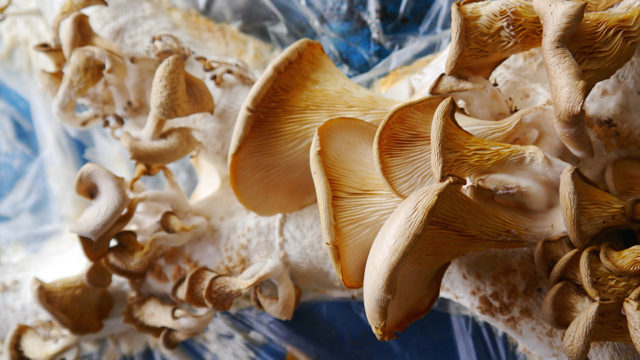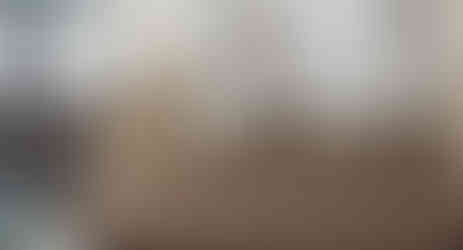For my design idea I was thinking of using mycelium as my building material, (you can read how it works in nature in THIS blog post). Now I want to have a look at how it works as a building material and how I could crate a big structure with it. To do so I have had a look at a few precedence and under what conditions it grows.
Precedence 1:
(Grown Structures: A Zero-waste Structure Made From Mycelium - MaterialDistrict, 2017)
By taking any type of mushroom, in this case oyster mushroom and mix it with cardboard and then finning a cotton bandages like sausages, they created this very organic structure that also give you gourmet mushrooms. In this design they let it grow in a greenhouse with good ventilation. This type of structure can be used and then biodegraded afterwards. This is a great example on how to build with mycelium, this is a small scale and I don't know how it would work to have a living material at a bigger scale outside. That brings us to precedence number 2.
Precedence 2:
(The Growing Pavilion - World Design Embassies, 2021)
This is mycelium panelling at a larger scale, I could not read anywhere if it is still living or if it has been burned. But from the look of it it looks like they have grown the pieces and then it has been burned. This shows that larger scale construction with this material is possible.
Precedence 3:
(Mycelium, n.d.)
This example shows how you can grow mycelium into different shapes and patterns to get any desired shape and form. You can easily find different ways to connect the pieces together.
How to grow it from spores:
"In order to grow mycelium from spores, you will need sterile equipment and materials, as well as a clean work environment.
1) First, sterilize all of your equipment and materials using either bleach or alcohol. This step is important in order to prevent contamination.
2) Next, add some water to your spores and mix them together until they are evenly distributed.
3) Now, it’s time to transfer the spore solution into an appropriate container for growing mycelium. You can use anything from plastic bags to mason jars – just make sure that the container has good ventilation.
4) Once the spores are in their container, place them in a warm (70-80 degrees Fahrenheit), dark location with high humidity. A terrarium or incubator would be ideal for this purpose. Keep an eye on the container over the next few days, and if you see any mold developing, remove it immediately to prevent contamination.
After about two weeks, you should start seeing mycelium growing!" (Orta, 2022b)
I also read about how to make mycelium bricks:
"Growing Mycelium Bricks In order to create mycelium bricks, you will need the following materials: -A block of mycelium (can be obtained from a local nursery or online)
-An organic material to act as a binder (such as straw, sawdust, or wood chips) -A container with drainage holes (a plastic storage bin works well) -Water
To start, cut your mycelium block into 1-2 inch pieces. If your mycelium is particularly dry, you can soak it in water for a few hours beforehand. Next, mix your mycelium pieces with the organic binder material until it is evenly distributed.
The ratio of binder to mycelium should be about 1:1 by volume. Once you have a homogenous mixture, pack it tightly into your container. Be sure to leave some space at the top of the container for air circulation.
Water your mixture generously and place the lid on top of the container. Mycelium bricks need warmth and moisture to grow, so place them in an area with temperatures between 70-85 degrees Fahrenheit and high humidity. A terrarium or greenhouse is ideal, but if you don’t have access to one of these environments you can create one by covering your container with clear plastic wrap or placing it on top of a heat mat set to “low.”
Check on your bricks daily, misting them lightly with water if they seem dry. In 10-14 days you should see white fuzz growing out of the brick – this is the mycelium! Allow the bricks to continue growing for another week or two before harvest.
To harvest, simply remove the lid from the container and cut the brick away from the sides of the container using a sharp knife. Your mycelium brick is now ready to use!" (Orta, 2022b)
The webpage talks about many different ways to grow mycelium, above soil, in soil, in a jar etc. The main points I get from the different ways to grow it is that humidity and a warmer temperature, is very important for it to grow well. The organic matter that needs to be added the substrate, such as wood chips or straw. To regulate this outside is not the easiest thing to do.
Mycelium as a building material:
Advantages:
"It is 100% biodegradable, hence temporary set-ups, installations can be easily erected and demolished based on usage.
Mycelium tissue can trap more heat than fiberglass insulation, it is also fireproof and non-toxic.
Wen dried, it becomes lighter due to porosity formation, but it is still stronger pound for pound than concrete.
The production of mycelium is not time-consuming. It is fast, low-cost and easily produced material.
There is almost no need for a bonding material since, when two mycelium bricks are placed together, they rapidly spread amongst them and become a bonding material.
If maintained in favourable and stable conditions, mycelium bricks can have a lifespan of approximately 20 years.
Disadvantages:
The capacity of resisting water decreases over time and thus the mycelium bricks become vulnerable to mould and humidity over time.
Mycelium bricks cannot be used for long term structures due to its decreasing resistance towards water, humidity and mould growth
Usually no coating is required under normal climatic conditions, mycelium bricks expand, contract and relax according to the weather and when they remain untouched from ground. If they touch the ground, there is moisture absorption that takes place, lowering the efficiency of the mycelium bricks. " (Happhoadmin, 2022)
Reading the advantages and disadvantages I think this material is perfect for me. Creating a structure that "unfortunately" is human designed for nature and animals. But with time the material will brake down and nature will take over completely. I will have created a structural base to promote growth in various ways. Just like in my precedence from Neri Oxman where they have designed this long term evolution of nature taking over New York, I have created a design where nature can take over and create its own space in its own way, just with a little help.
References:
Grown Structures: A zero-waste structure made from mycelium - MaterialDistrict. (2017, August 25). MaterialDistrict. https://materialdistrict.com/article/grown-structures-mycelium/
The Growing Pavilion - World Design Embassies. (2021, October 13). World Design Embassies. https://www.worlddesignembassies.com/en/growing-pavilion/
Mycelium. (n.d.). Designing Buildings. https://www.designingbuildings.co.uk/wiki/Mycelium
Orta, E. (2022, December 8). Growing Mycelium - Terrarium Station. terrarium Station. https://terrariumstation.com/growing-mycelium/
Happhoadmin. (2022). An Emerging Sustainable Construction Material – Mycelium Bricks. Happho. https://happho.com/an-emerging-sustainable-construction-material-mycelium-bricks/




























Comentarios